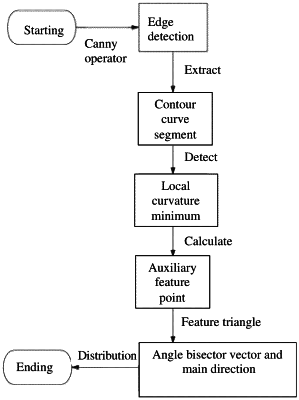| CPC G06T 7/13 (2017.01) [G06T 3/14 (2024.01); G06T 7/149 (2017.01)] | 8 Claims |

|
1. A heterogeneous image registration method comprising,
using a Canny edge detection operator to perform edge detection on collected images, in combination with a curvature scale space strategy to extract contour curved segments in an edge image;
implementing a feature point detection strategy based on global and local curvature detecting feature points in the contour curved segments, and obtaining the nearest minimum local curvature of the feature points pointing to starting and end points of the contour curved segments, respectively; wherein the detecting of the feature points comprising:
using the Canny edge detection operator to detect an edge binary image of the collected images, and extracting the contour curved segments in the edge image;
calculating curvature of each point in the contour curved segments, using a maximum curvature point on the contour curved segments as a candidate feature point, storing and detecting a nearest local minimum curvature point at both ends of each maximum point;
calculating an average curvature value of each candidate feature point in the neighborhoods of the contour curved segments;
setting a curvature multiple threshold, such that when the curvature of the candidate feature point is less than a product of the average curvature value multiplied by the curvature multiple threshold, the candidate feature point is eliminated;
when the curvature of the candidate feature point is greater than the product of multiplying the average curvature value by the curvature multiple threshold, calculating whether the candidate feature point is on a circular contour; if so, the candidate feature point is rejected; otherwise, the candidate feature point is retained;
calculating a positional relationship of the retained candidate feature point; if an angle between one of the feature points and two neighborhood feature points on the same contour is less than the curvature multiple threshold, defining the candidate feature point as the feature point; otherwise, the candidate feature point is eliminated; and
taking a first point and a last point of each unclosed contour as the feature points, and ending the extracting the feature points;
calculating a number of neighborhood sampling points and neighborhood auxiliary feature points of neighborhoods on both edges of each of the feature points according to the nearest minimum local curvature;
using the neighborhood auxiliary feature points and the feature points to form a feature triangle, and calculating an angle bisector vector and a main direction corresponding to the feature point in the feature triangle;
wherein the main direction points to a concave edge of a contour of the feature points to complete a main direction distribution.
|